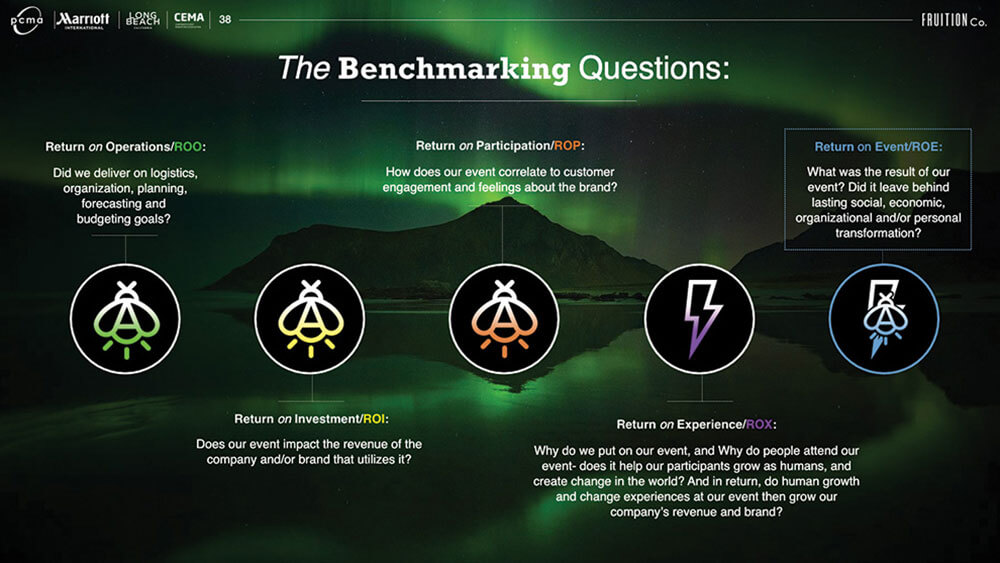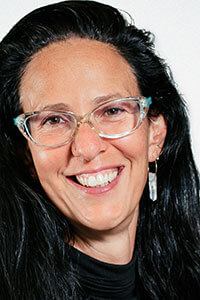
The difference between concentrating only on what’s easily quantified while equally attending to the more fluid, nonmaterial return on experi- ence is the difference between a jar that you’ve filled with lightning bugs and a jar in which you’ve managed to catch lightning. (Illustration by Cordell Ross, Fruition Co.)
Back in January — what seems like a lifetime ago — an accomplished and diverse group of business event strategists, brand experience managers, designers, and association and marketing executives came together at the Long Beach Convention & Entertainment Center in Long Beach, California, for a two-day immersive think tank, where they talked about new ways to measure the value of business events.
Assembled by PCMA, Marriott International, the Long Beach Convention & Visitors Bureau, and the Corporate Event Marketing Association (CEMA), and led by the innovation strategy consultancy Fruition Co., the experts convened to explore a different set of questions about metrics and value. They challenged each other to think about how corporations and organizations might move beyond the traditional, single-metric approach to measurement — the return on investment (ROI) in events — to consider more integrated, bigger-picture ways that measure the value and impact of events.
Their insights and aha moments, augmented with additional interviews with stakeholders and experts, became the basis for the report, Beyond ROI to ROE (Return on Events): Measuring the Impact of Business Events. It’s designed not just to be read, but to be implemented; the report’s cross-functional framework includes a set of tools that business events professionals in a variety of roles can use to both uncover and evaluate new dimensions of the impact of the events.
From Where We Started to Now
When the think tank conversations got underway in Long Beach in January, meeting rooms and airplanes were full. The business events industry supported 10.3 million direct jobs globally and generated more than $1 trillion of direct spending and business events-related travel — numbers radically changed by COVID-19’s impact. But what hasn’t changed is how business events have remained a top priority for companies and organizations — the pandemic couldn’t and didn’t stop people from meeting. When the coronavirus created travel restrictions and made meeting in person physically unsafe in many parts of the world, within a matter of days, individuals were gathering online at business events by the thousands and tens of thousands, driven by the search for knowledge and inspiration, for new ideas and strategies for growing their careers and businesses, to connect with others working to solve the same problems, or simply to share a human experience.

The study shows how to measure the value of an event through five lenses: ROO, ROI, ROP, ROX, and ROE. (Fruition Co.)
Events Have a New Definition
As digital experiences became the primary medium for events over the last 10 months, the very definition of events has shifted from in-person events held in physical spaces being the default, to something that is not so constrained by time and the channels in which they occur. Events have a new definition: a gathering of people with shared interests who meet in the mediums where they are — whether it’s in person, online, or a combination of the two. Something else has radically changed as well: The pandemic has forced the business events industry to rethink its business and operational models, along with organizational roles, releasing an explosion of innovation and experimentation in digital meeting design and delivery.
DOWNLOAD the Report: Beyond ROI to ROE (Return on Events): Measuring the Impact of Business Events
Which means that the timing couldn’t be better for the introduction of a new methodology and a set of tools that can measure the return on events — in whatever mediums they are held — in new ways. “ROE [Return on Events] was always meant to recognize the need to blend the digital and physical worlds,” said Scott Miles, principal at The Atipikal Company, a virtual strategy, creative, and design company, who participated in the Long Beach conversations. “The pandemic has only served to accelerate this reality.”

Amy Blackman
The experts who came together in Long Beach represented different groups that tend to work from a list of objectives and metrics defined by their individual roles, said strategist Amy Blackman, the founder and principal of Fruition Co. in Los Angeles. Event strategists, for example, “look at an event through the lens of the Return on Operations (ROO), asking questions about whether the event itself made money, or whether the space, location, platform, and/or medium worked to support the event’s needs,” Blackman said. And boards and business leaders tend to look at events in terms of Return on Investment (ROI), asking if an event made money for the brand or organization itself, or increased the audience size, sales pipeline, the brand reach or market share, she said. The third group, marketing professionals, think primarily in terms of the Return on Participation (ROP), Blackman said. They ask themselves whether participating in the experience resulted in changes in sentiment or behavior, or in increased loyalty or advocacy on the part of participants.
Catching Lightning in a Jar
Those questions about ROO, ROI, and ROP are associated with measurable metrics that are quantifiable, Blackman said. Another set of questions often have been considered to be immeasurable and intangible, Blackman said — “the qualitative stuff.” But can an event be successful, she asked — and the experts in Long Beach asked themselves — “if we can’t answer the most fundamental questions, such as why are we creating an experience, and why would people attend? Or what exactly do humans gain by having experiences at events? And do human growth and change experiences at our event then grow our company’s revenue and brand?” Blackman calls this the Return on Experience (ROX) — which shows up in ways that can be assessed, such as inspiration, mind shifts, fun, play, and personal enrichment. “Are these things harder to measure than dollars-in, dollars-out?” Blackman asks. “Perhaps. But is it necessary to measure them? Definitely.”
The difference between concentrating only on what’s easily quantified while equally attending to the more fluid, nonmaterial return on experience is the difference between a jar that you’ve filled with lightning bugs and a jar in which you’ve managed to catch lightning, Blackman said. “It’s capturing something powerful and elusive — and then being able to hold it and show it to the world.”

Naomi Clare
“The North Star for me when driving toward Return on Experience [ROX] is figuring out how we are delivering connection,” said experience designer Naomi Clare, founder of Storycraft Lab, and one of the project’s experts. “Whether that is socially with other humans, building community, sharing excitement and energy, or connecting with brands, with marketing messages, with content, with products, with the sales cycle.” The trick, she added, “is understanding what aspect of connection is of value to our audience: What matters to them? What do they need the experience to be? That’s where using empathy to understand our audiences is a constant. While their needs may be changing and evolving, we must constantly meet them with empathy and inquiry so that we can deliver value that is meaningful.”
Miles, an experience designer, uses shareability as a yardstick, whether experiences are digital, in-person, or a hybrid of the two. “Experiences at their core, wherever they may occur, drive sharing,” Miles said. “Whether in the form of stories, recommendations, or educational materials, experiences are meant to impact us personally to the degree that we want to relay them to others.”
“To go back to the question about why we do events, I think, fundamentally, as human beings, we have a need to connect and experience community. … This framework is a means to build that experience and interject that magic,” said Michael Clarke, director of B2B marketing & customer engagement events, Marriott International. This methodology, he added, “is a starting place, because nothing like this exists out there.”
A New Way to Add It All up
After the strategists, executives, and marketing team add up the ROO, ROI, ROP, plus ROX, one more set of big questions remains on the journey to arriving at the ROE — the Return on Event: What was changed, impacted, and transformed as a result of our event? Did the event leave behind lasting social, economic, organizational, and/or personal transformation?
This is where the model’s approach is fundamentally novel, Blackman points out. Its thesis is that to measure the true outcome of an event, the multiple perspectives and conclusions about what constitutes success must be gathered, considered, and combined. It’s an aggregate definition of impact rather than a siloed one. This is the appeal of Return on Events — it is comprehensive, integrating all of the priorities and perspectives of the entire organization to formulate a new definition of impact.
RELATED: Enroll in the 7 Change Actions Course
“One of the things we don’t do enough of, or frankly, do any of, in some cases, is measuring true outcomes, the true difference that we’re making,” said Karen Malone, vice president of meeting services & sales, HIMSS North America. “It goes beyond the revenue for the show and the organization. What kind of difference are we making in the world?”
Tools That Only Will Get Sharper
The current constraints on the meetings industry are real — but they won’t last forever. When large groups of people can once again meet together in person, event producers can apply the new knowledge and experience about how digital marketing and digital event experiences impact growth to their strategic decision-making. In the future, “we’ll still get to travel,” Blackman said. “We’ll still get to go someplace and sit around a fire and talk to people. And we’ll have a new, deeper, wider, more comprehensive set of tools for measuring how meetings and events impact growth — socially, economically, organizationally, and personally.”
Barbara Palmer is deputy editor of Convene.
